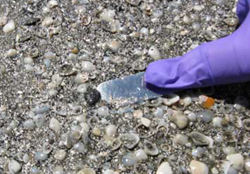WHOI Scientists Study the Fate of Oil
April 2012 - Shorlty after the Deepwater Horizon disaster, a research team led by scientists at Woods Hole Oceanographic Institution (WHOI) began visiting Grand Isle, Louisiana to sample. Members of the WHOI lab have revisited the site four or five times in the past year and the most recent visit was April 19, when Dr. Chris Reddy collected numerous samples. "Grand Isle was heavily oiled after the blowout." Reddy explains. "And despite an excellent clean-up, you can still find 'sand patties' that . At Grand Isle, they are small (0.5 cm to 3 cm and as think as a penny or two. Oil on all these samples was analyzed at WHOI using comprehensive two-dimensional gas chromatography. The technique identifies the thousands of individual chemical compounds that comprise different oils from different reservoirs. The goal is to study what happens to the many hydrocarbons in oil -- weather or change with time. Every chemicals has a different personality towards biodegradation, photochemical breakdown, etc. I am intersted in knowing who is the most susecptable to each process. And, of course, when does weather stop and we can identify the '"toughest compounds". This is interesting research as it provides insights into the natural weathering of oil. Of course, we want to know what is left to learn more about engineered clean-ups. “The results shed a brighter light on the fate and behavior of the oil,” said Reddy, “and may help to prepare for future spills.” This type of long-term monitoring is done for oil spills or revisit old ones. The Woods Hole Oceanographic Institution is a Deep-C partner institution. WHOI is a private, independent, non-profit organization in Falmouth, Mass., dedicated to marine research, engineering, and higher education. Established in 1930 on a recommendation from the National Academy of Sciences, its primary mission is to understand the ocean and its interaction with the Earth as a whole, and to communicate a basic understanding of the ocean's role in the changing global environment. |
Deep-C was a four-year, interdisciplinary study of deep sea to coast connectivity in the northeastern Gulf of Mexico.Deep-C is no longer an active research project. The information on this website is for historical reference purposes only.
Home | About Us | Research Areas | Data Center | News & Multimedia | Education & Outreach
© Deep-C Consortium. All Rights Reserved.
This research was made possible by a grant fromThe Gulf of Mexico Research Initiative (GoMRI).
Copyright | Disclaimer | Privacy Policy

